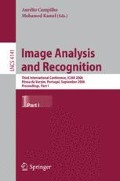Abstract
Although motion extraction requires high computational resources and normally produces very noisy patterns in real sequences, it provides useful cues to achieve an efficient segmentation of independent moving objects. Our goal is to employ basic knowledge about biological vision systems to address this problem. We use the Reichardt motion detectors as first extraction primitive to characterize the motion in scene. The saliency map is noisy, therefore we use a neural structure that takes full advantage of the neural population coding, and extracts the structure of motion by means of local competition. This scheme is used to efficiently segment independent moving objects. In order to evaluate the model, we apply it to a real-life case of an automatic watch-up system for car-overtaking situations seen from the rear-view mirror. We describe how a simple, competitive, neural processing scheme can take full advantage of this motion structure for segmenting overtaking-cars.
Access this chapter
Tax calculation will be finalised at checkout
Purchases are for personal use only
Preview
Unable to display preview. Download preview PDF.
References
Reichardt, W.: Autocorrelation, a principle for the evaluation of sensory information by central nervous system. In: Rosenblith, W.A. (ed.) Sensory Communication, pp. 303–317 (1961)
Mota, S., Ros, E., Ortigosa, E.M., Pelayo, F.J.: Bio-Inspired motion detection for blind spot overtaking monitor. International Journal of Robotics and Automation 19(4) (2004)
Mota, S., Ros, E., Díaz, J., Ortigosa, E.M., Agís, R., Carrillo, R.: Real-time visual motion detection of overtaking cars for driving assistance using FPGAs. In: Becker, J., Platzner, M., Vernalde, S. (eds.) FPL 2004. LNCS, vol. 3203, pp. 1158–1161. Springer, Heidelberg (2004)
Haag, J., Borst, A.: Encoding of visual motion information and reliability in spiking and graded potential neurons. Journal of Neuroscience 17, 4809–4819 (1997)
Gonzalez, R., Woods, R.: Digital Image Processing. Addison-Wesley, Reading (1992)
Clifford, C.W.G., Ibbotson, M.R., Langley, K.: An adaptive Reichardt detector model of motion adaptation in insects and mammals. Visual Neuroscience 14, 741–749 (1997)
Ros, E., Pelayo, F.J., Palomar, D., Rojas, I., Bernier, J.L., Prieto, A.: Stimulus correlation and adaptive local motion detection using spiking neurons. International Journal of Neural Systems 9(5), 485–490 (1999)
Barlow, H.B.: The efficiency of detecting changes of intensity in random dot patterns. Vision Research 18(6), 637–650 (1978)
Field, D.J., Hayes, A., Hess, R.F.: Contour integration by the human visual system: evidence for local “association field”. Vision Research 33(2), 173–193 (1993)
Saarinen, J., Levi, D.M., Shen, B.: Integration of local pattern elements into a global shape in human vision. Proceeding of the National Academic of Sciences USA 94, 8267–8271 (1997)
Gilbert, C.D., Wiesel, T.N.: Intrinsic connectivity and receptive field properties in visual cortex. Vision Research 25(3), 365–374 (1985)
Ross, M., Wenzel, T.: Losing weight to save lives: a review of the role of automobile weight and size in traffic fatalities. Report from the American Council for an Energy-Efficient Economy, ACEEE-T013 (2001)
Franke, U., et al.: From door to door- Principles and Application on Computer Vision for driver assistant systems. In: Proceeding of Intelligent Vehicle Technologies: Theory and Applications (2000)
Handmann, U., et al.: Computer Vision for Driver Assistance Systems. In: Proceeding of SPIE, vol. 3364, pp. 136–147 (1998)
Schneider, R., Wenger, J.: High resolution radar for automobile applications. Advances in Radio Science 1, 105–111 (2003)
Ewald, A., Willhoeft, V.: Laser Scanners for Obstacle Detection in Automotive Applications. In: Proceedings of the IEEE Intelligent Vehicle Symposium, pp. 682–687 (2000)
Heisele, B., Neef, N., Ritter, W., Schneider, R., Wanielik, G.: Object Detection in Traffic Scenes by a Colour Video and Radar Data Fusion Approach. In: First Australian Data Fusion Symposium, pp. 48–52 (1996)
Fang, Y., Masaki, I., Horn, B.: Depth-Based Target Segmentation for Intelligent Vehicles: Fusion of Radar and Binocular Stereo. IEEE Transactions on Intelligent Transportation Systems 3(3) (2002)
Author information
Authors and Affiliations
Editor information
Editors and Affiliations
Rights and permissions
Copyright information
© 2006 Springer-Verlag Berlin Heidelberg
About this paper
Cite this paper
Mota, S., Ros, E., Díaz, J., Agis, R., de Toro, F. (2006). Bio-inspired Motion-Based Object Segmentation. In: Campilho, A., Kamel, M.S. (eds) Image Analysis and Recognition. ICIAR 2006. Lecture Notes in Computer Science, vol 4141. Springer, Berlin, Heidelberg. https://doi.org/10.1007/11867586_19
Download citation
DOI: https://doi.org/10.1007/11867586_19
Publisher Name: Springer, Berlin, Heidelberg
Print ISBN: 978-3-540-44891-4
Online ISBN: 978-3-540-44893-8
eBook Packages: Computer ScienceComputer Science (R0)

